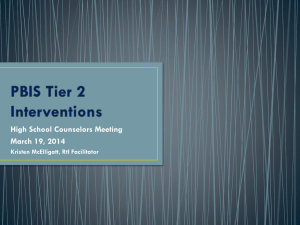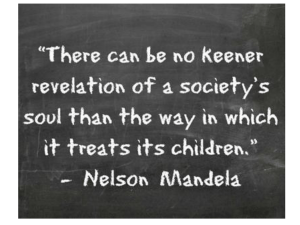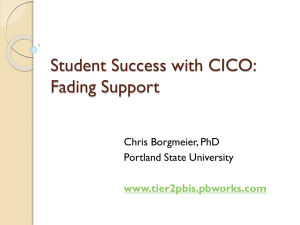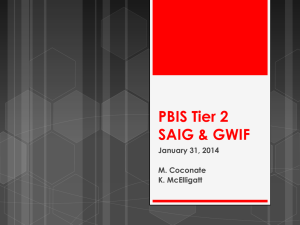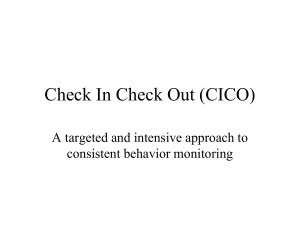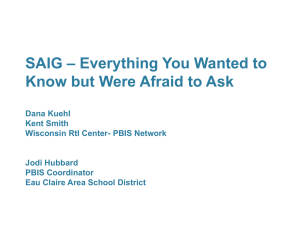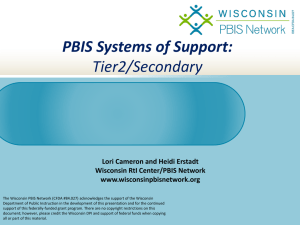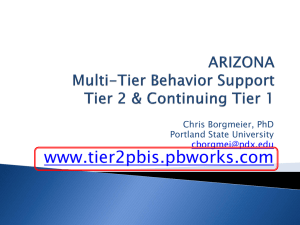Tier 2 Continuumx
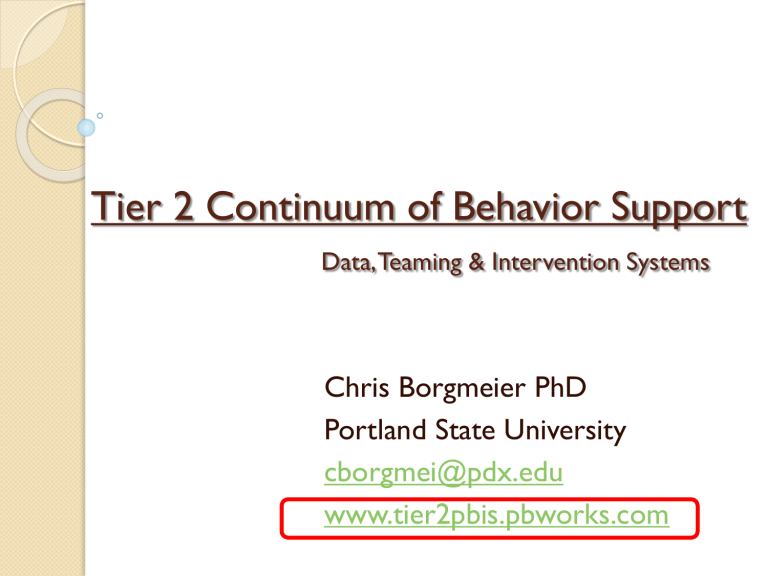
Tier 2 Continuum of Behavior Support
Data, Teaming & Intervention Systems
Chris Borgmeier PhD
Portland State University cborgmei@pdx.edu
www.tier2pbis.pbworks.com
Few
Minutes
Tier 2 & 3 Logic
Assessment & Intervention
Many
Minutes
Intensive
Increasing Minutes
Spent on Assessment and Intervention
Targeted
Few
Minutes
Universal
School-Wide Assessment
School-Wide Prevention Systems
Teaming Structures & Processes
Screening
Decision Rules
Progress Monitoring
Individual PBIS
Efficient Teaming Process
◦ Clear roles, procedures & responsibilities
Intervention Focused
◦ Linked to Continuum of Interventions (Tier 1 2 3)
◦ Try the easy things first (Tier 2 Interventions)
◦ …then Tier 3 (FBA/BSP)
Data focused & Early Identification
◦ Progress Monitoring
◦ Student Identification through Systematic Screening
Individual PBIS
Team Responsibilities
Monitor Systems
(Tier 2 & Tier 3)
Universal
Screening &
Identifying
Students at risk
Individual PBIS Team
Tier 2/3 Progress Monitoring
(Systems & Students)
Team Members:
Administrator
Behavior Specialists
-e.g. SPSY, SPED
CICO Coordinator
-e.g. counselor, IA
Meets every 2 wks 30-45 min.
Monitor
Student
Progress
Match
Students to
Intervention
Sept. 1, 2009
RESPONSE TO INTERVENTION (RTI)
From Tier 2 to Tier 3
Tier I
Universal
SWPBIS
Team
Plans SW
& Classwide supports
Tier II
Progress
Monitoring
Team
Monitors effectiveness and fidelity of
Tier 2
Interventions
(overall and for each student)
Trust the System -- Tier 2 Process
Maximizing # of minutes/ student
Tier III
FBA Team
Conducts FBA, develops BIP
NOT a standing team
Student 1
FBA/BSP team
Administrator
Behavior Specialist
Student Centered team
Student 4
FBA/BSP team
Administrator
Behavior Specialist
Student Centered team
Individual PBIS Team
Tier 2/3 Progress Monitoring
(Systems & Students)
Team Members:
Administrator
Behavior Specialists
-e.g. SPSY, SPED
CICO Coordinator
-e.g. counselor, IA
Meets every 2 wks 30-45 min.
Student 2
FBA/BSP team
Administrator
Behavior Specialist
Student Centered team
Student 3
FBA/BSP team
Administrator
Behavior Specialist
Student Centered team
Student Screening &
Identification
Emphasize early identification
Individual PBIS
Team Responsibilities
Monitor Systems
(Tier 2 & Tier 3)
Universal
Screening &
Identifying
Students at risk
Individual PBIS Team
Tier 2/3 Progress Monitoring
(Systems & Students)
Team Members:
Administrator
Behavior Specialists
-e.g. SPSY, SPED
CICO Coordinator
-e.g. counselor, IA
Meets every 2 wks 30-45 min.
Monitor
Student
Progress
Match
Students to
Intervention
Universal Screening
Before the 1
st
Day of School
Review Data from last year
◦ Your school data
◦ And data on incoming students (if available)
Identify students who had Behavior Support Plans in place per IEP (or otherwise)
◦ Prepare to implement BSP with necessary modifications from beginning of the school year
Identify returning students with more than 5 referrals last year who might benefit from behavioral support to begin the year
Previous Years Discipline data
Who needs to be on our radar from Day 1?
Who had FBA/BSP’s last year?
Which students moved on? Which are returning this year?
Can we get data for our incoming class & new students?
Decision Rule
Returning Students (8+ referrals)
Three returning students had FBA/BSPs last year
◦ Students w/ 16, 11, & 10 referrals
◦ Make modifications to last years BSP & prepare to implement from beginning of school year
These returning students did not have behavioral interventions in place last year
Plan a Check-In Event
Robbie - 9 referrals last year
Jaden - 8 referrals last year
Jorge – 10 referrals last year
Logan – 11 referrals last year
(orientation) for students before the school year begins
Start Supports from the beginning of year –
NO WAITING TO FAIL!
Galen - 11 referrals last year
Get all 5 started on CICO during 1 st week of school
Continuing Screening through the
Year
I-PBS team reviews student referral data every 2 weeks at each meeting
◦ Many referrals might also go directly to the
CICO manager
Develop Decision Rules for continuing
Student Identification through the year
◦ Example: Students receiving 3 rd referral or 2 nd in a month
Tier 2 & 3 -- RTI
Assessment & Intervention
Wraparound Supports
Refer to Tier 3 team:
Practical FBA
Non-Responder
Preliminary FBA
Borderline
Initial CICO Data
Screening
Referral Data
(ODRs)
Intensive
Individualized Behavior
Support Plan
Modified CICO
Matched to Function
Targeted
“Tweak”/ Small change to CICO
Basic CICO
Universal
School-Wide Assessment
School-Wide Prevention Systems
Team Tasks – Universal Screening
Develop a plan for Universal Screening to implement before Day 1 of the school year:
◦ Who will meet? when? & where?
◦ What data will you use to ID students for intervention?
◦ Develop DECISION RULES for identifying students:
At the beginning of the year?
On a continuing basis throughout the year
◦ Using your current data, which students do you want to target for intervention NOW & Next Fall?
◦ What interventions & activities will you implement to support these students from the beginning of the school year?
CICO
FBA/BSP
Other?
Tier 2 & 3
Continuum of Interventions
Tier 2 & 3
Continuum of Interventions
Wraparound Supports
Intensive
Individualized Behavior
Support Plan
Modified CICO
Matched to Function
Targeted
“Tweak”/ Small change to CICO
Basic CICO
Universal
School-Wide Assessment
School-Wide Prevention Systems
Questions about Tier 2 Interventions
Systems Considerations
What constitutes a Tier 2 Intervention?
◦ EFFICIENCY & MAXIMIZING RESOURCES
◦ An intervention that:
Serves multiple students at one time (15-25 student at once)
More efficient use of resources that 1 student at a time
Students can get started with almost immediately upon referral
Requires almost no legwork from referring staff to begin implementation of the intervention with a student
All school staff know about, understand their role with, and know the referral process for
◦ SYSTEMS NOTE: Resources Required:
If program is not self-sufficient… and requires significant organization by referring staff… it’s not a Tier 2/ targeted intervention
CICO from Simple to Advanced
Start with Basic CICO
◦ Should work for the majority of at-risk students
◦ Complete CICO Fidelity Assessment
Once implementing CICO with fidelity & using data for decision making
◦ Data for student identification
◦ Data for student progress monitoring to ID responders/borderline/non-responders
Start adding variations of CICO
Major Features of Targeted Interventions
Intervention is continuously available
Rapid access to intervention (72 hr)
Very low effort by teachers
Consistent with school-wide expectations
Implemented by all staff/faculty in a school
Flexible intervention based on assessment
◦
Functional Assessment
Adequate resources (admin, team)
◦ weekly meeting, plus 10 hours a week
Student chooses to participate
Continuous monitoring for decision-making
CICO: Implementation Checks
SYSTEM
◦ Person assigned with FTE to coordinate & manage daily implementation of CICO
◦ Bi-weekly team meetings for student referral/ identification for CICO & progress monitoring
◦ Materials & incentives readily available
◦ Staff-wide buy-in, commitment & training in roles, responsibilities related to CICO
Regular updates to staff on student data & implementation
CICO: Implementation Checks
PRACTICES
◦ Reliable daily am check-in & pm check-out
◦ Students earn rewards for success (daily at first)
◦ Not punitive
CICO: Implementation Checks
DATA
◦ Daily collection of point card data
◦ Regular review of graphic student data for decision making (at least every 2 weeks)
◦ Regular student referral for early identification of at-risk students
Data Collection
Focus on Efficiency
Generic point card
◦ Expectations linked to School-wide rules
◦ Limited individualization
◦ We do not want to spend time tailoring the point card at this level of intervention
Generic Point Card
No time spent individualizing
Team Task:
1. Take a few minutes to complete the BEP-FIM as a Self Assessment.
2 = In Place
1 = Partially In Place
0 = Not in Place
2. Identify actions necessary to address areas to improve CICO implementation
CICO: Advanced Applications
Small Modifications or “Tweaks”
Additional Tier 2 Interventions
Remember focus on Efficiency in Progress
Monitoring Meeting
◦ Minutes per Student
Tweak or Small CICO Modification
Alternate Tier 2 Intervention (Function-based)
Escalate to Tier 3 Student Centered team
Trust the Process
◦ Most difficult thing = not talking about a student before it’s time
Tier 2 Assessment & Intervention
Intensive
Borderline
Initial CICO Data
Student
Referral Data
(ODRs)
Targeted
Universal
School-Wide Assessment
School-Wide Prevention Systems
“Tweak”/ Small change to CICO
Basic CICO
Small Changes
“Tweaks”
In Progress Monitoring meetings – always weighing
Minutes/Kid
◦ Tweaks to the plan for Borderline Responders should only take a couple of “minutes”
◦ Look at initial CICO data
◦ Not an extensive discussion
Should have a menu of quick changes/ “tweaks”:
◦ Change CICO mentor
◦ Change incentives
◦ Change/individualize goals
◦ More frequent check-ins -- “adding hair”
Borderline Responder
Last 3 weeks -- 10 of 16 days over 80%, but last 8 days -- 3 of 8 days over 80%
“just missing”… but downward trend
Good Candidate for a Small Change/ “Tweak”
In 2 minutes or less - Which change is most likely to work for this student?
Change (a) CICO mentor, (b) incentives, (c) individualize goals OR
(d) more frequent check-ins
Borderline Responder
Look at Initial CICO data
Quick Check:
Anything we can do about Period 3?
Ready to Make Quick Changes
Readiness – what needs to be ready to make these
‘quick’ changes?
◦ Change/individualize goals
Need alternate point card readily available to individualize
◦ Change CICO mentor
◦ Add Mid-Day Check-in & incentive
◦ Change incentives
Individualize incentives for the student
◦ More frequent check-ins
With teacher? With CICO Specialist?
Need an adjusted point card?
Individualized Point Card
Fill in more specific behaviors
Individualized Point Card
Robbie Oct. 14 th 20--
More Frequent Check-Ins
“CICO Hair Club for Kids”
•Teacher gives more frequent feedback by applying hair – then uses hair to inform overall score for period
•Another Alternative – Create alternate card which breaks day into smaller intervals
Team Work Time
What ‘tweaks’ do you want to develop to be ready for borderline responders?
◦ Adapt existing materials and/or Develop new materials required to make ‘tweaks’
readily available and accessible?
◦ Remember in the meeting, decisions regarding small intervention changes or ‘tweaks’ should occur in less then 2 minutes of discussion….
“Ready to Go” intervention options/ “tweaks” will make this as easy as possible
Non-Responders
Modified (Function-Based) CICO
Tier 2 Assessment & Intervention
Intensive
Non-Responder
Preliminary FBA
Borderline
Initial CICO Data
Student
Referral Data
(ODRs)
Targeted
Universal
School-Wide Assessment
School-Wide Prevention Systems
Modified CICO
Matched to Function
“Tweak”/ Small change to CICO
Basic CICO
Non-Responder
Typical Reasons CICO may not be working for an individual student
Address
Implementation
Issue
1)
2)
Individualize
Tier 2
3)
4)
Escalate to
Tier 3 Support
5)
Low fidelity of implementation
The student needs more instruction on how to use the program
The rewards are not powerful or desirable for the student
The program does not match the function of the problem behavior
The student requires more intensive, individualized support
Behavioral Explanations for “Why”
Don’t forget - From student’s perspective, problem behavior serves a purpose, such as…
◦ Gaining attention
◦ Gaining access to activities or tangible items
◦ Avoiding or escaping from something student finds unpleasant (e.g. difficult or undesired tasks)
Using Function of Behavior to Inform
CICO Modifications
Individual Student Planning
◦ Can use “Function of Behavior” to match students to appropriate version of CICO
◦ Function-Based Assessment might include:
Data from ODRs “Possible Motivation”
Or Preliminary/Brief FBA
Minor – “Uh-Oh”
Preliminary FBA
Use existing data for preliminary FBA
◦ ODR data
Identify function/motivation
Identify antecedents – time/location/persons involved, etc.
◦ CICO data
Identify antecedents – time/location
Non-Responder
Preliminary FBA
Does this tell us anything about when/ where/ who is involved (antecedents)?
Preliminary FBA
Discipline Referral Summaries
◦ Suspensions, detentions, office referrals
◦ Look for patterns
Triggers/Antecedents Day of the week, Time of
Day, Location, Students Involved
Behavior
Consequences/Function Possible Motivation,
Disciplinary Action, Administrative Decision
Student Referral Report - SWIS
Date Staff Time Location
Prolem
Behavior
1 02/08/11 43866 12:15PM Plygd Agg/Fight
2 01/28/11 47522 1:30PM Class Disrespt
Motivation
Unknown mot
Others
Involved
Peers
Admin
Decision
Out-sch susp
Avoid Task Teacher Detention
3 01/10/11 47522 10:30AM Class
4 12/18/10 47522 9:30AM Class
Disrespt
Disrespt
Avoid Task
Avoid Task
Teacher
Teacher
Detention
Detention
5 12/08/10 47522 1:00AM Class
6 12/08/10 47522 10:15AM Class
Disrespt
Disrespt
Avoid Task Peer Detention
Avoid Task Teacher Parent
7 11/20/10 47522 9:30PM Class
How about when/ where/ who (Antecedents)?
Disrespt Avoid Task Teacher Parent
Does this tell us anything about the function of student behavior?
Advanced Applications of CICO
Function-Based Modifications of CICO
Breaks Are Better
Function = Escape Task (elem)
Justin Boyd
University of Oregon
Logic Guiding Breaks are Better
Children may benefit from taking small, appropriate breaks
If breaks are available, students may:
◦ Engage in less escape-maintained problem behavior
◦ Request breaks less often than escape-maintained problem behavior occurred
Increased reinforcement for:
◦ Asking for assistance
◦ Taking a break appropriately
CICO Modification Elementary
Escape Academic Task
Explicitly teach an alternative/replacement behavior (i.e., break requests)
Promote self-management by teaching students to “keep track” of their breaks
Establish & Teach teachers (and students) how this will look in the classroom
Make it feasible and sustainable for classroom teachers to implement
Breaks are Better Modifications
Prior to intervention:
◦ Child & teacher identify appropriate “break” activities
◦ Student is taught:
How to request a break
How to take a break
How to return to work
Points earned for:
◦ Meeting academic-specific expectations
◦ Asking for break appropriately or not needing a break
◦ Weekly point total tied to reinforcers
Sample Break Options & Rewards
Break Options
Move to separate desk for quiet activity
Quiet activity at desk
Drawing
Doodle on notebook
Stretch in backroom
Run errand for teacher
Weekly Rewards
Computer time
Extra Recess
Coupon for bonus points on assignments
Coupons for buddy work
Coupon to make assignment shorter or easier
Library pass
Breaks are Better Card
Taking a Break in the Classroom
ABC: Academic Behavior CICO
Function = Escape Task (MS)
Jessica Turtura
University of Oregon
Logic Guiding ABC
Students benefit from organizational structure
More frequent and tangible reinforcement for:
◦ Recording assignments
◦ Completing in-class work & participating
◦ Asking for help
◦ Completing homework
Parental structure for homework completion:
◦ Parents are aware of assignments
◦ Parents check for completion
Academic focused CICO (Escape Tasks)
Middle School
•
•
•
•
Morning Check-in
– Students check-in with counselor
– All homework completed? Prepared for the school day with all necessary materials?
– Opportunity to complete unfinished homework and to gather materials
Daily point card and Homework tracker
– Receive feedback each period about behavior during class (participation, staying ontask, completing work)
– Record assignments on homework tracker
Afternoon Check-out
– Check-out with counselor
– Review point card and homework tracker
– Does student know what is due tomorrow? Have all materials needed to complete assignments?
Home Component
– Parents review daily feedback with student
– Sign card to indicate if student has completed all homework
ABC Modifications
Prior to intervention – coordinator meets w/ parents
Morning Check-In: Assess & give bonus pts for:
◦ Materials Ready & Homework Completed
Afternoon check-out: Check Tracker
Expectations focus on Academic Behaviors + Add’l
Expectation of completing Tracker
Parent signature with focus on Homework
Completion
ABC Point Card -- Front
ABC Point Card -- Back
Non-Responders
Escalate to Tier 3
Tier 2 Assessment & Intervention
Refer to Tier 3 team:
Practical FBA
Non-Responder
Preliminary FBA
Borderline
Initial CICO Data
Student
Referral Data
(ODRs)
Intensive
Individualized Behavior
Support Plan
Modified CICO
Matched to Function
Targeted
“Tweak”/ Small change to CICO
Basic CICO
Universal
School-Wide Assessment
School-Wide Prevention Systems
Non-Responder
Tweak ABC
CICO
After multiple interventions , including match to function-based CICO
RTI Time to move to Tier 3 Support
Student 1
FBA/BSP team
Administrator
Behavior Specialist
Student Centered team
Meeting 1
Permissions
Coordinate
Assessment (FBA)
Meeting 2
Review Assessment&
Finalize
Implementation Plan
Meeting 3
Monitor Student
Progress &
Review/Modify
Plan
Individual PBIS Team
Tier 2/3 Progress Monitoring
(Systems & Students)
Team Members:
Administrator
Behavior Specialists
-e.g. SPSY, SPED
CICO Coordinator
-e.g. counselor, IA
Meets every 2 wks 30-45 min.
Meetings
Ongoing as needed to
Monitor Student Progress &
Review/Modify Plan
Student 1
FBA/BSP team
Administrator
Behavior Specialist
Student Centered team
Student 4
FBA/BSP team
Administrator
Behavior Specialist
Student Centered team
Individual PBIS Team
Tier 2/3 Progress Monitoring
(Systems & Students)
Team Members:
Administrator
Behavior Specialists
-e.g. SPSY, SPED
CICO Coordinator
-e.g. counselor, IA
Meets every 2 wks 30-45 min.
Student 2
FBA/BSP team
Administrator
Behavior Specialist
Student Centered team
Student 3
FBA/BSP team
Administrator
Behavior Specialist
Student Centered team
A Proactive Approach to Behavior Support
Planning
• Majority of problem behaviors that teams encounter do not require comprehensive FBA-BSP (Loman & Horner, in press)
• Using simplified FBABSP procedures that “match” the level and intensity of problem behavior
• Provide FBS at the first signs of persistent problem behavior
Basic FBA:
Behaviors and Maintaining
Functions are Easily Defined and Identified
Complex FBA:
Behaviors and Maintaining
Functions Vary, and are not Easily
Defined and/or Identified
District Behavior
Support Specialist
Train and coach PBIS at all three tiers
Support
Teams building behavior support plans from
Assessment information
Train 1-2 people per school to conduct
“basic”
FBA/BSP
Building Capacity for Function-
Based Support
Basic FBA2BSP Training
Series of 7 - 90 minute trainings
(each training spaced about 2 weeks apart)
◦ Session 1: Basics of Behavior
◦ Session 2: FBA Interview
◦ Session 3: FBA Observation
◦ Session 4: Function-Based Intervention
◦ Session 5: Behavior Support Planning
◦ Session 6: Implementation Planning
◦ Session 7: Evaluation Plan & Monitoring
Format of
Basic FBA to BSP Training Sessions
Objectives Checks for
Understanding
Review
Activities
Comments/
Questions
Tasks
Key Points
